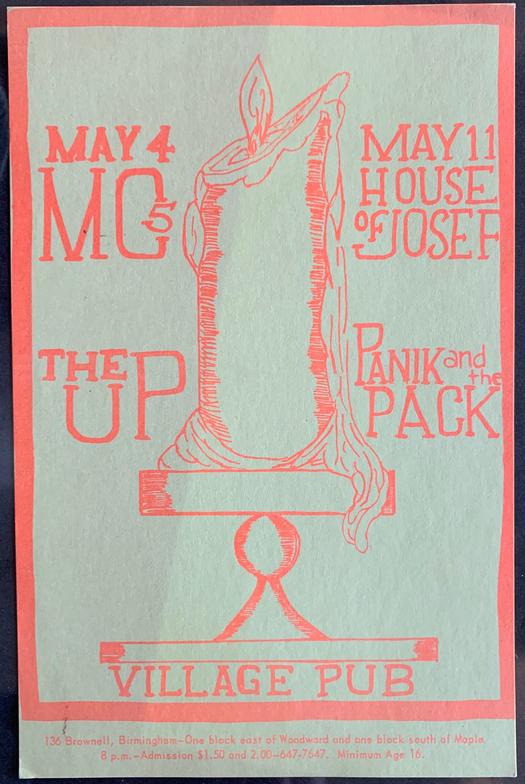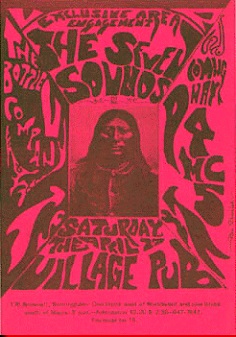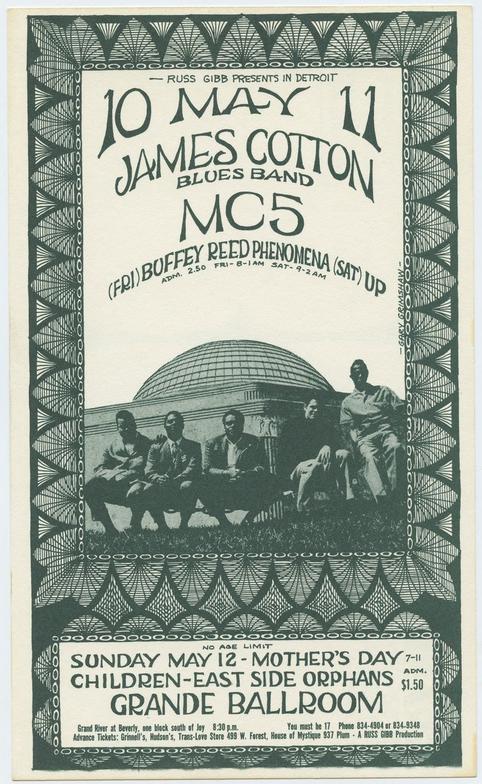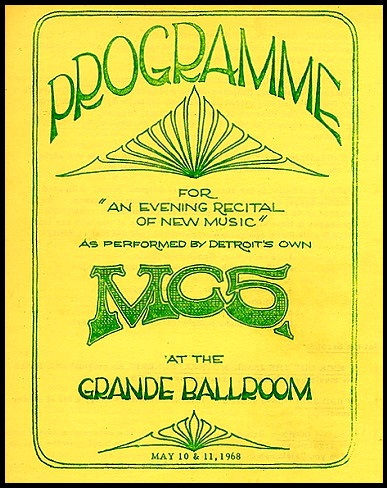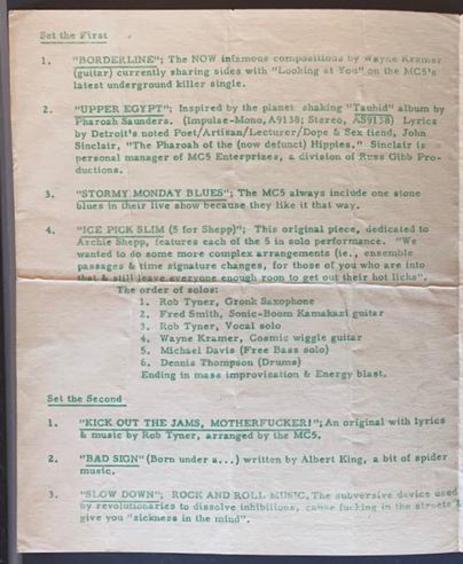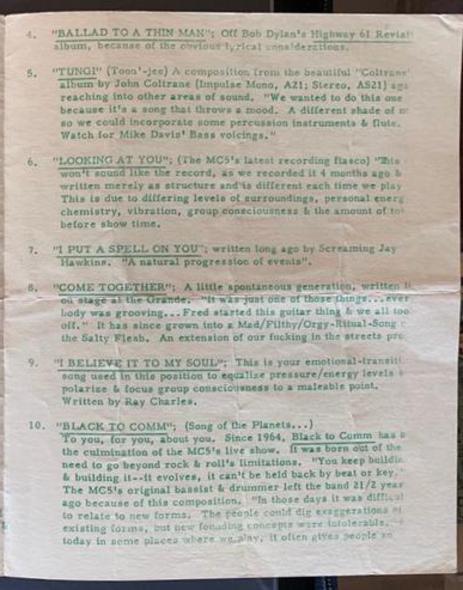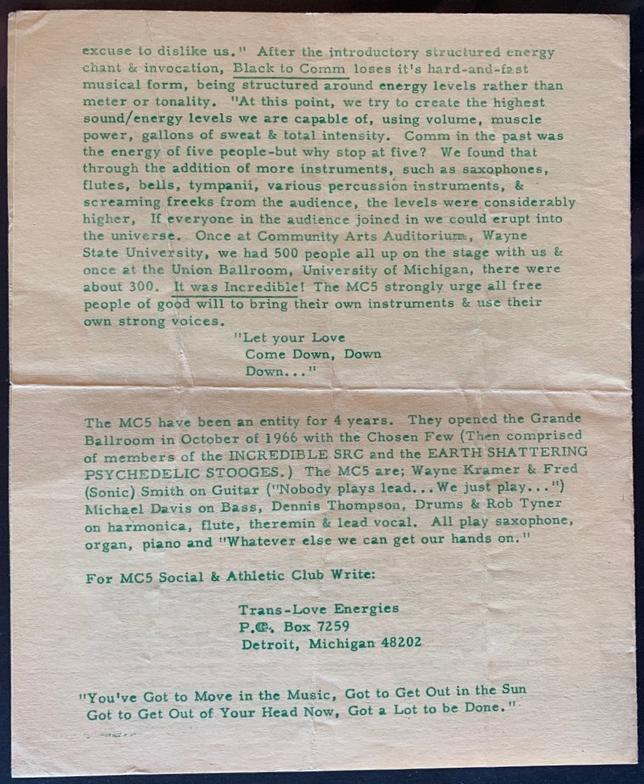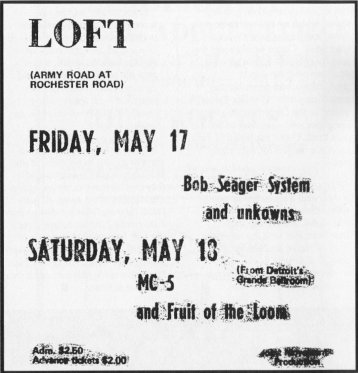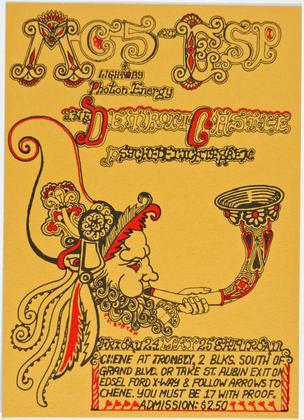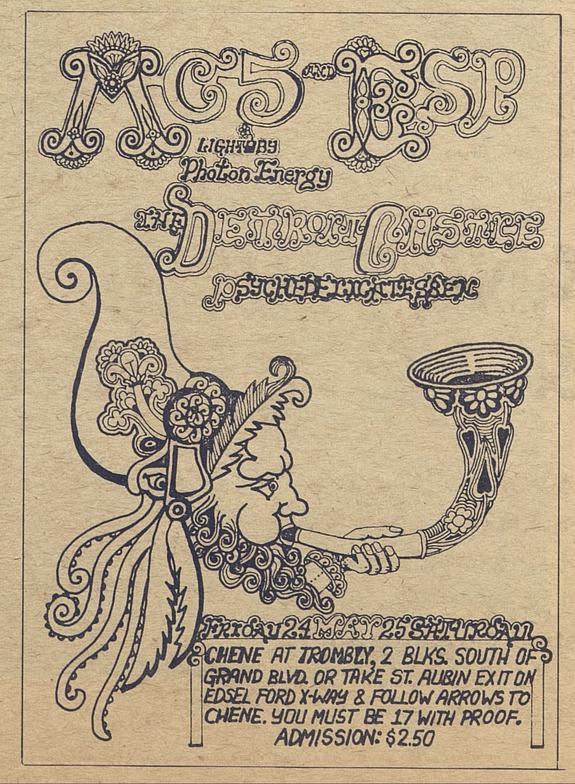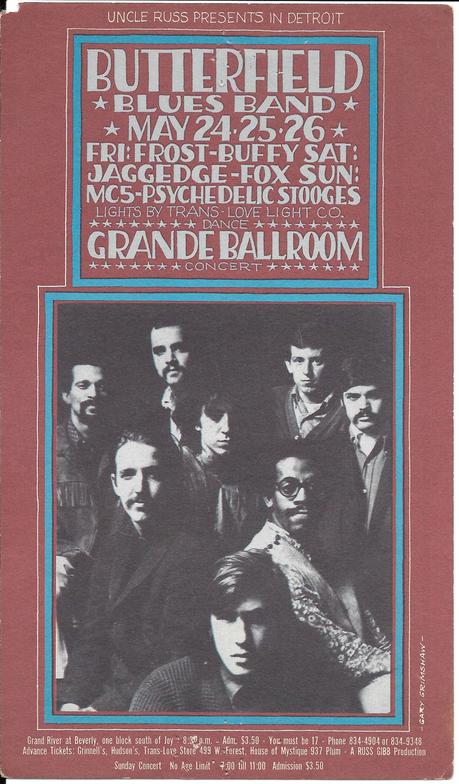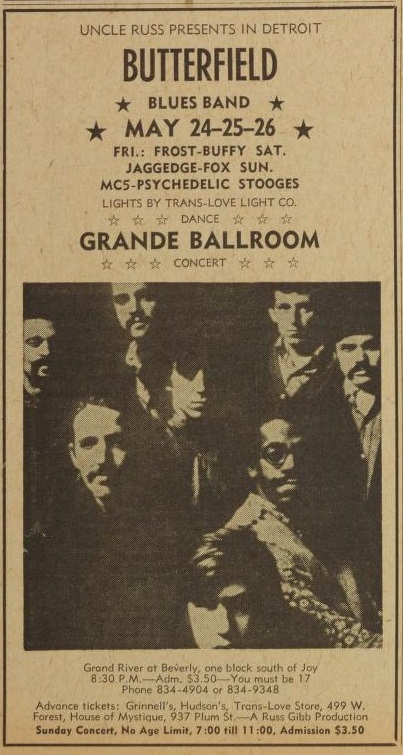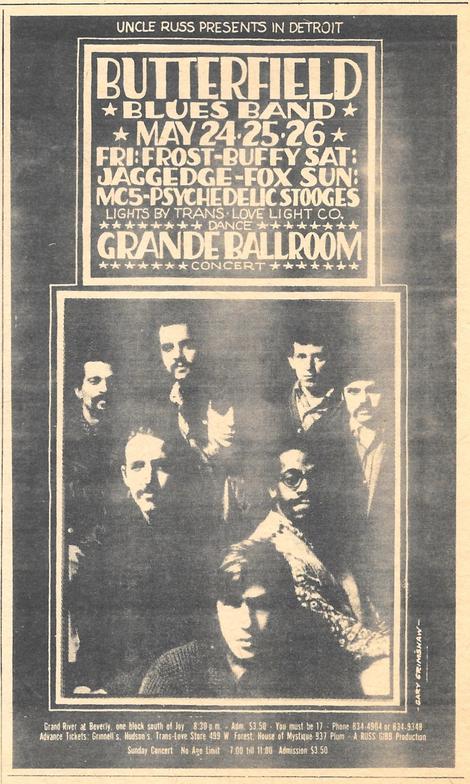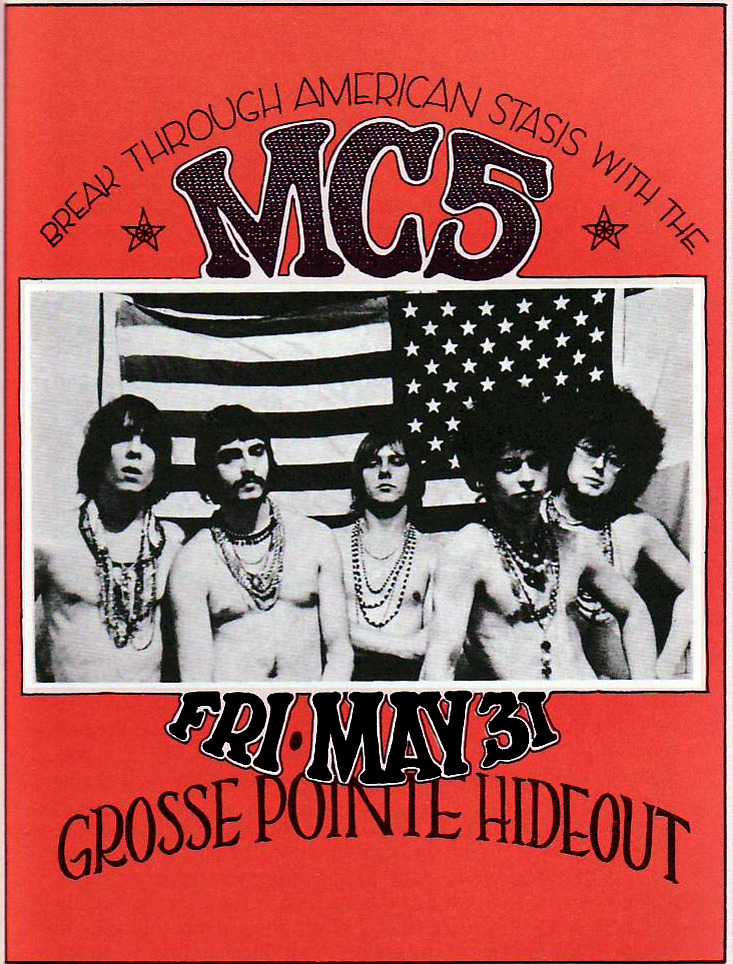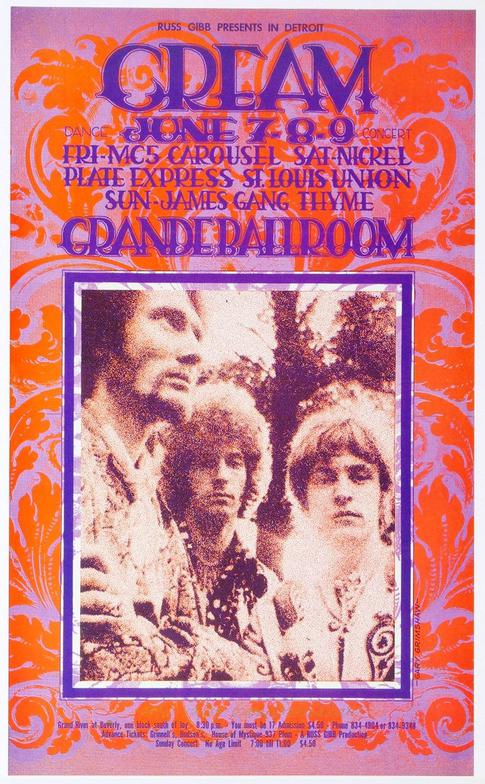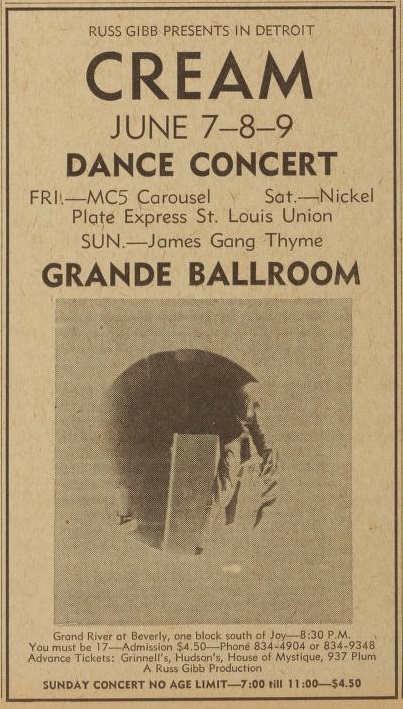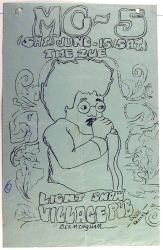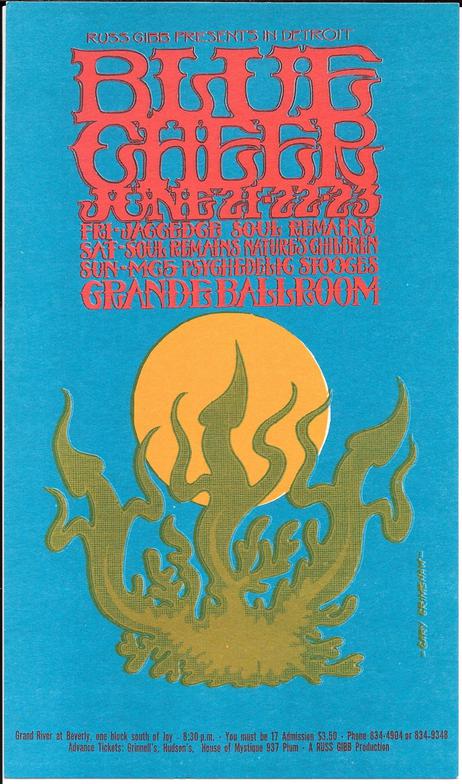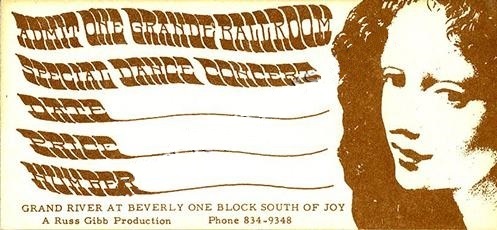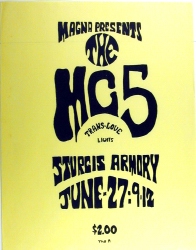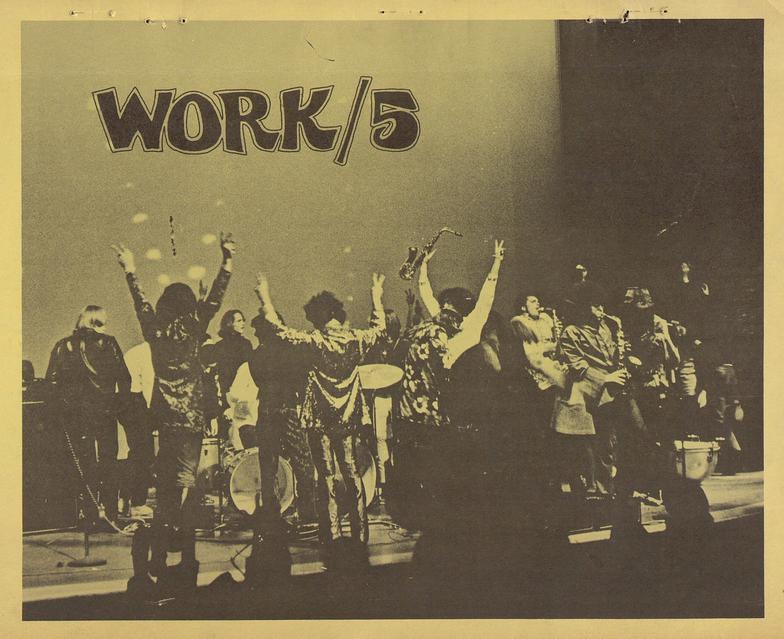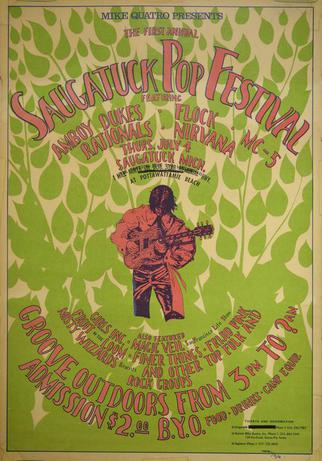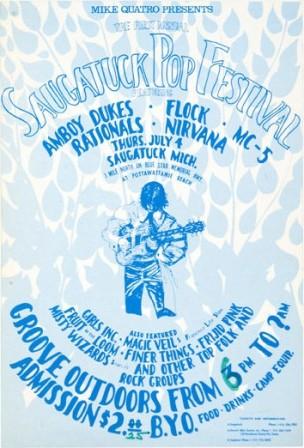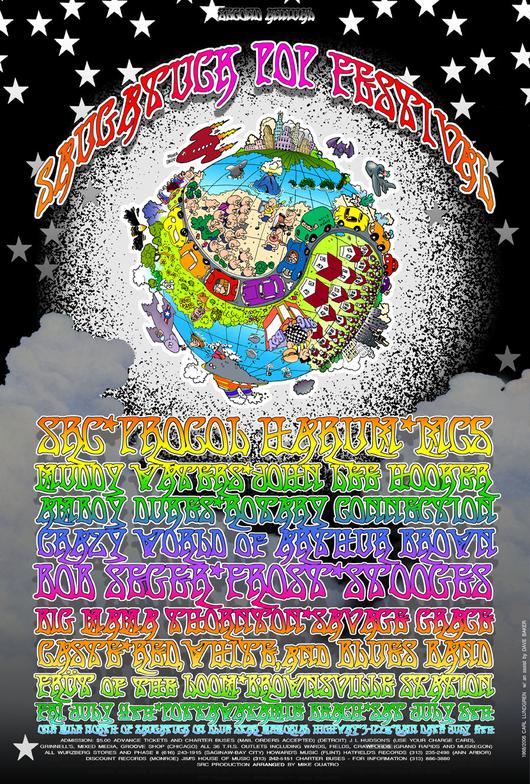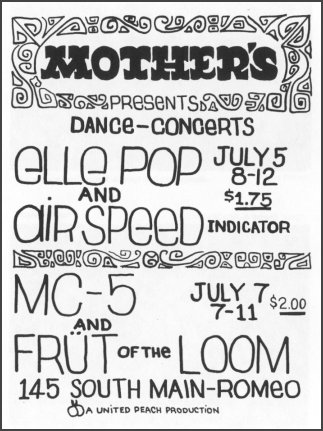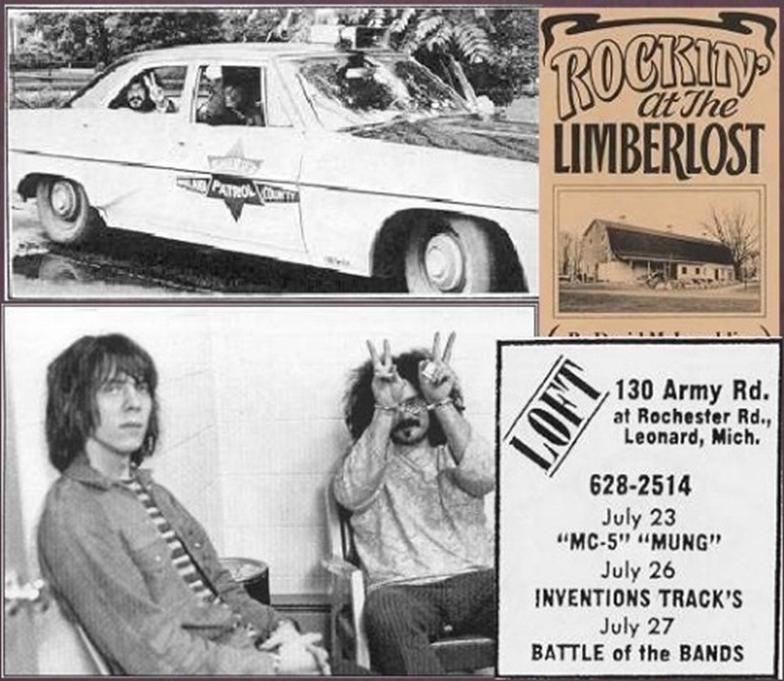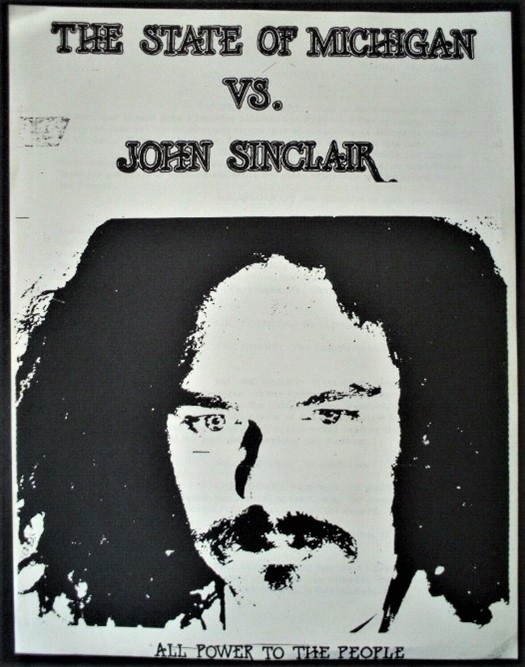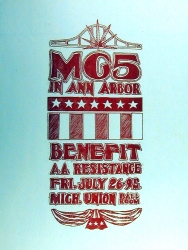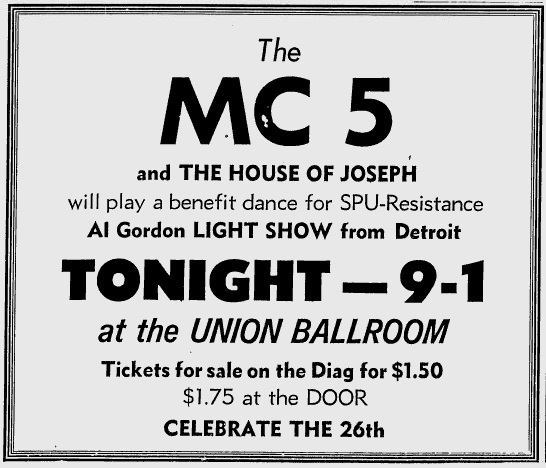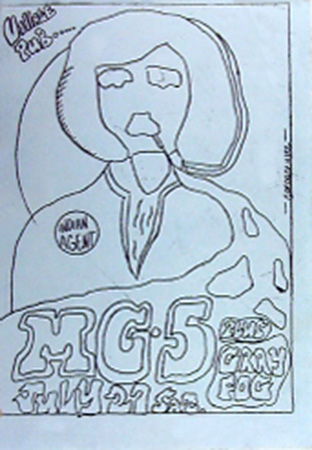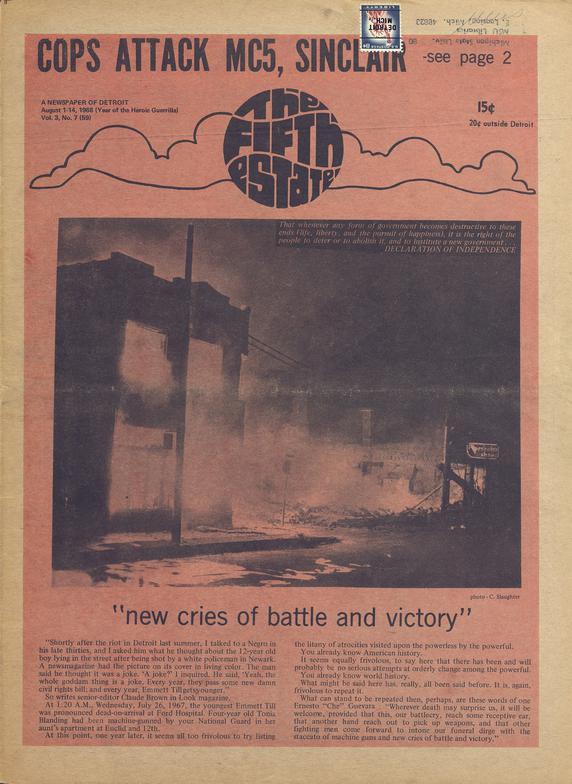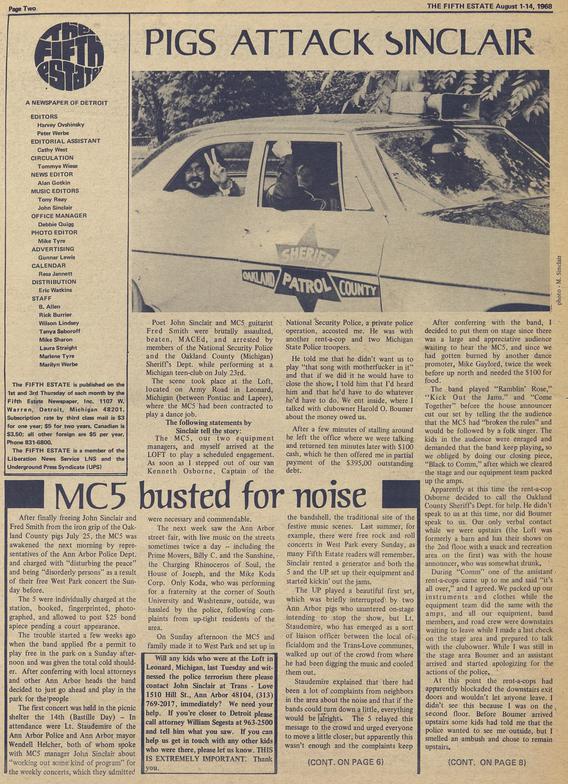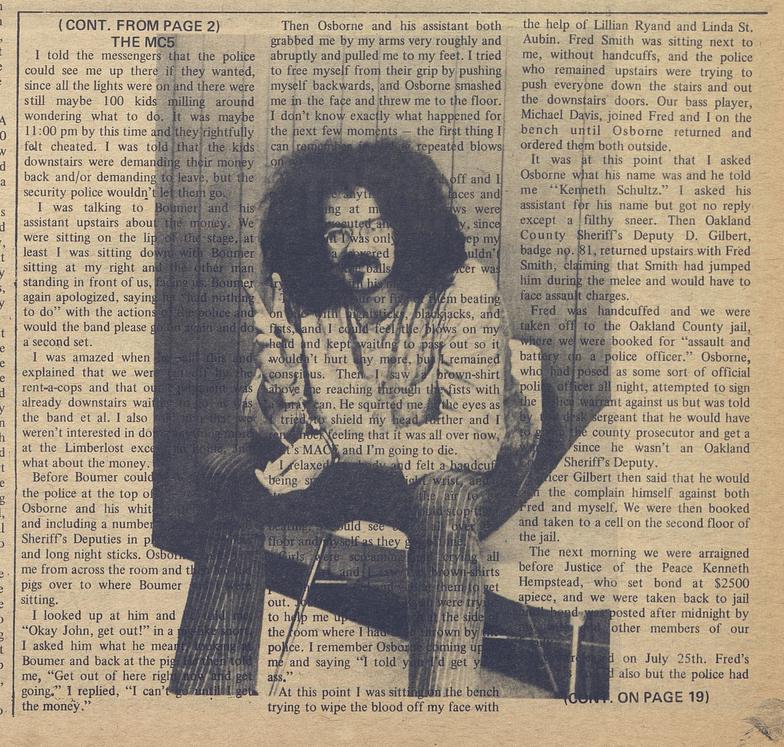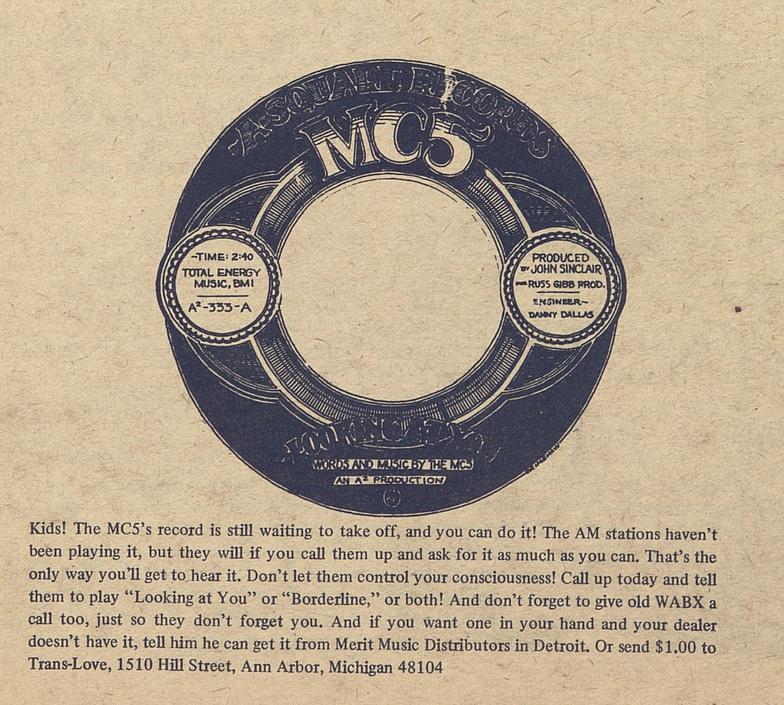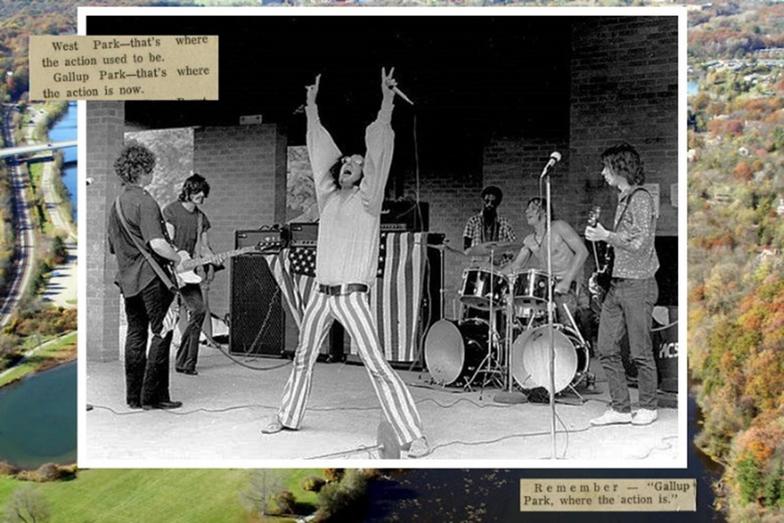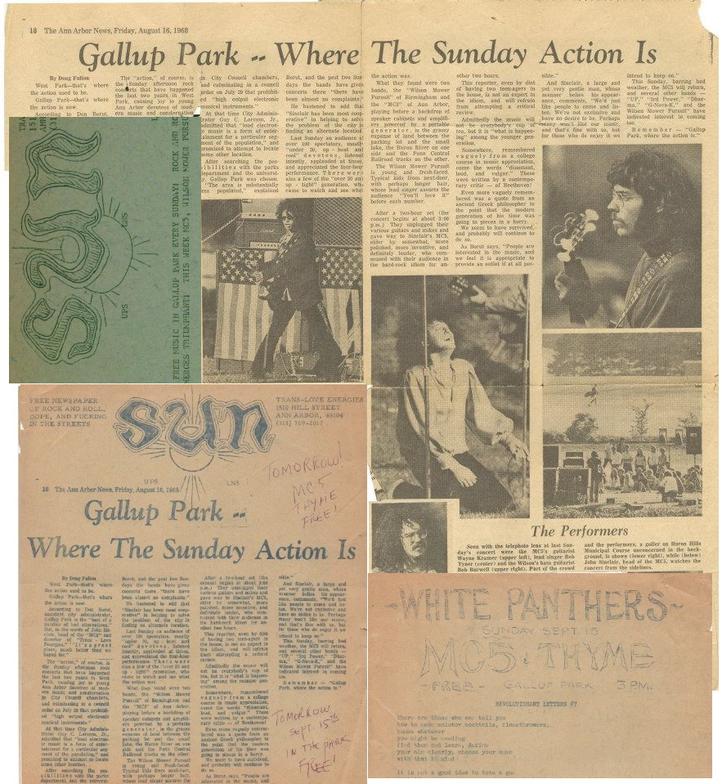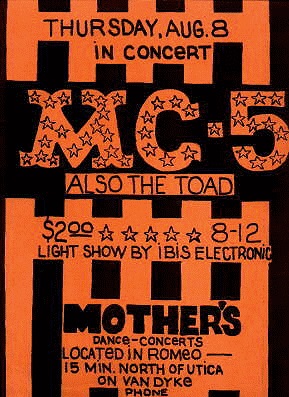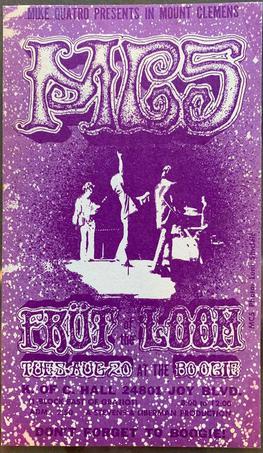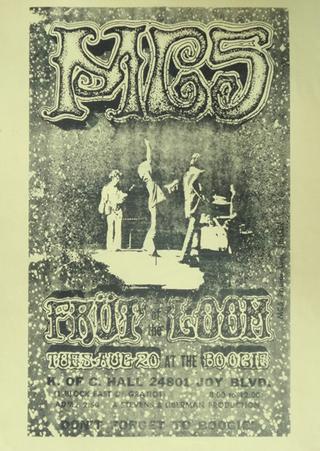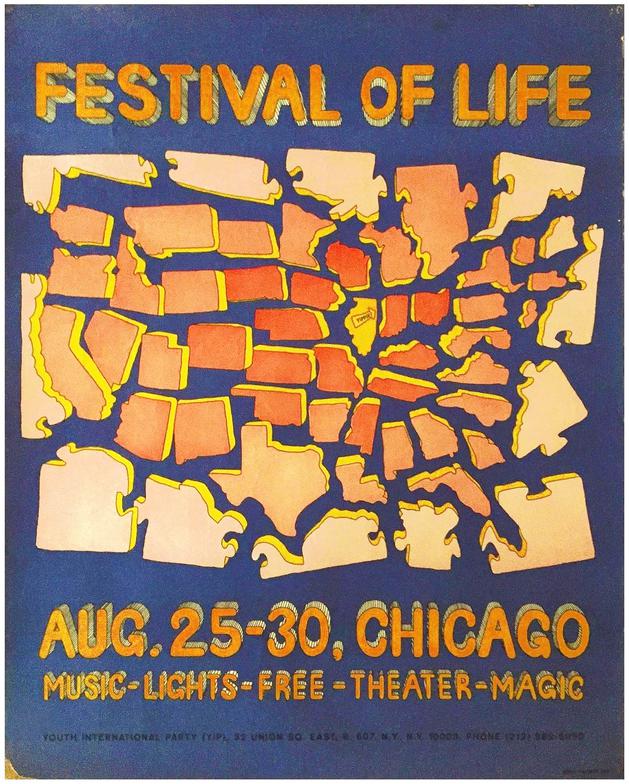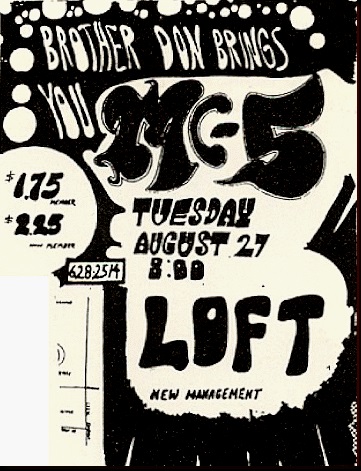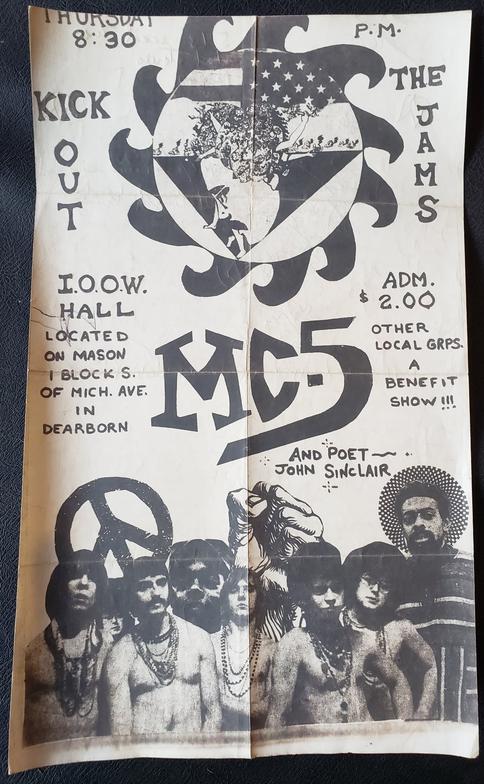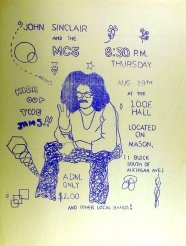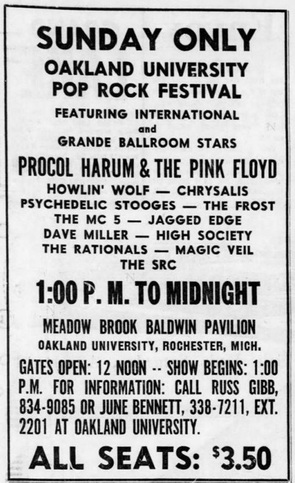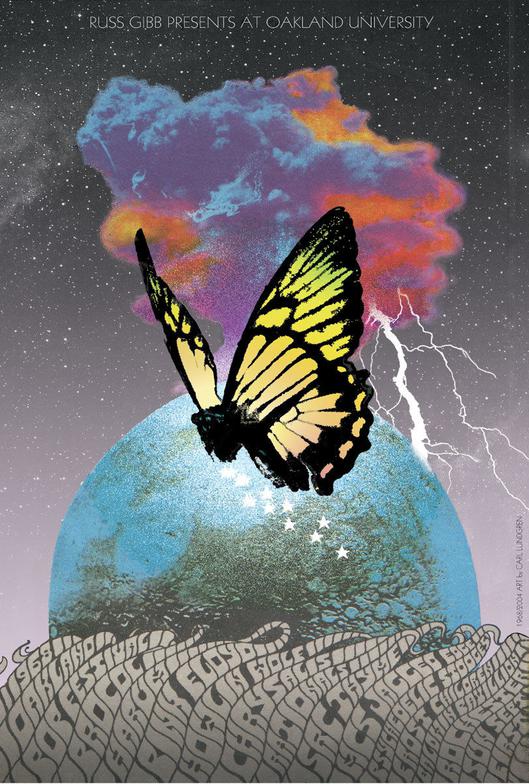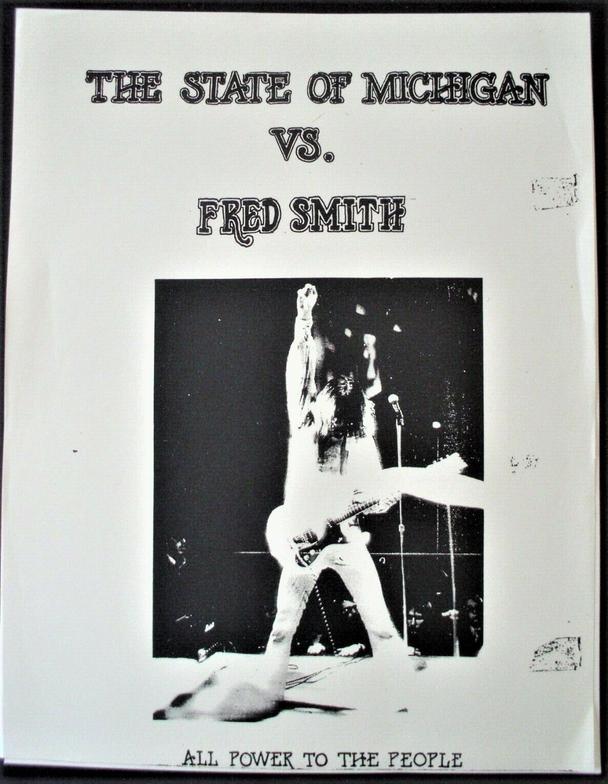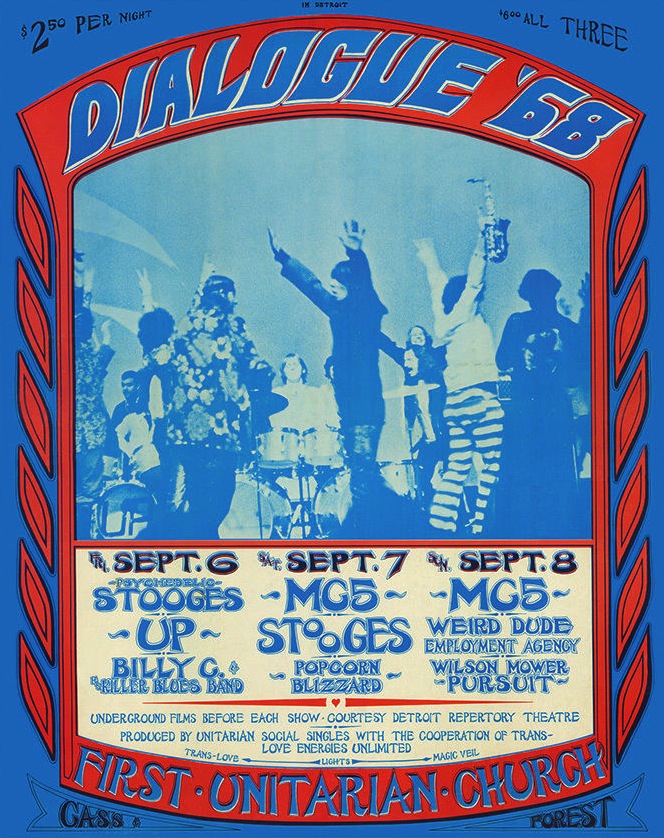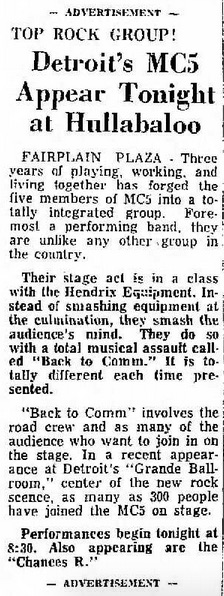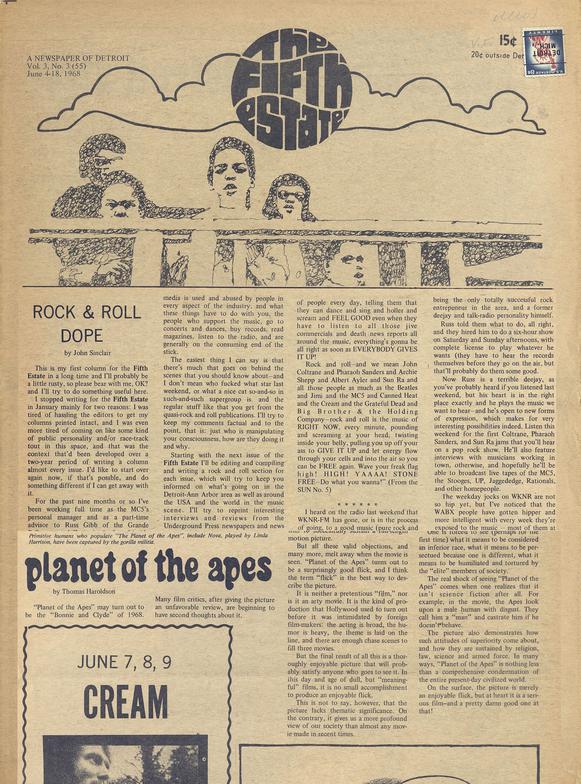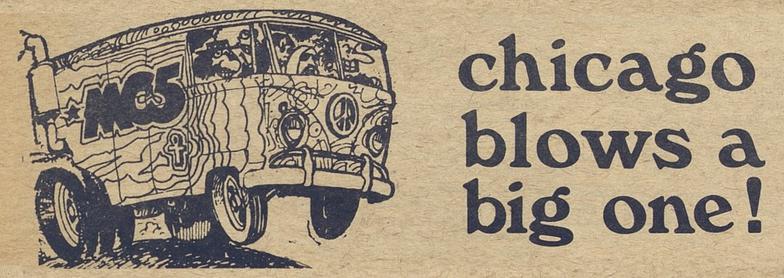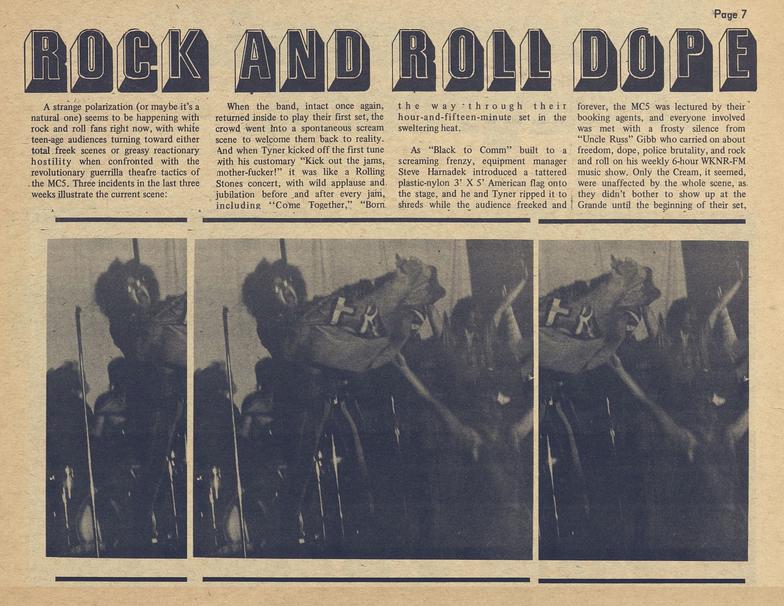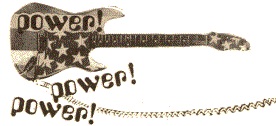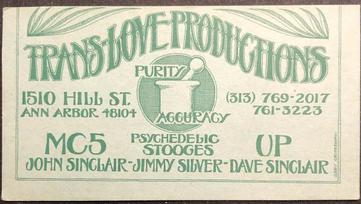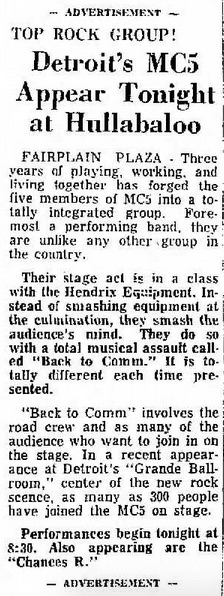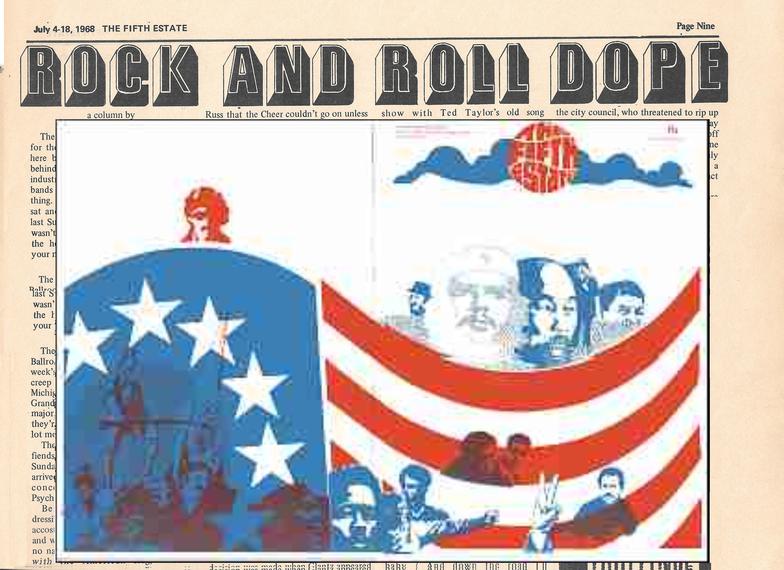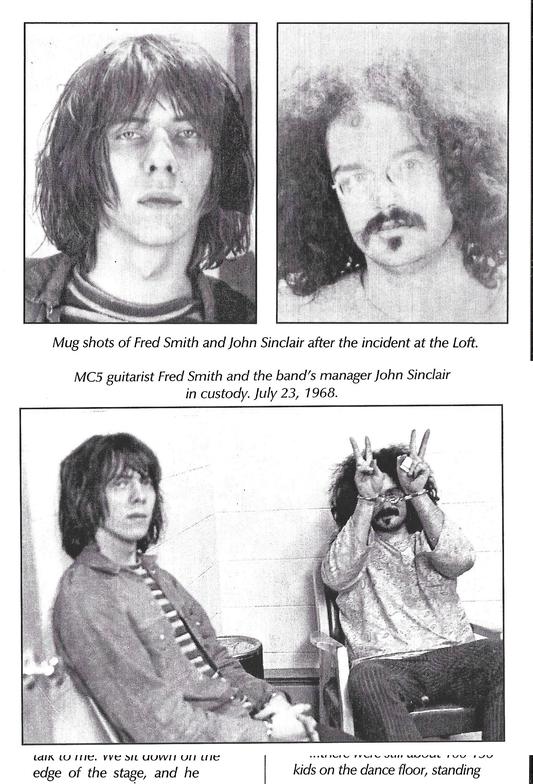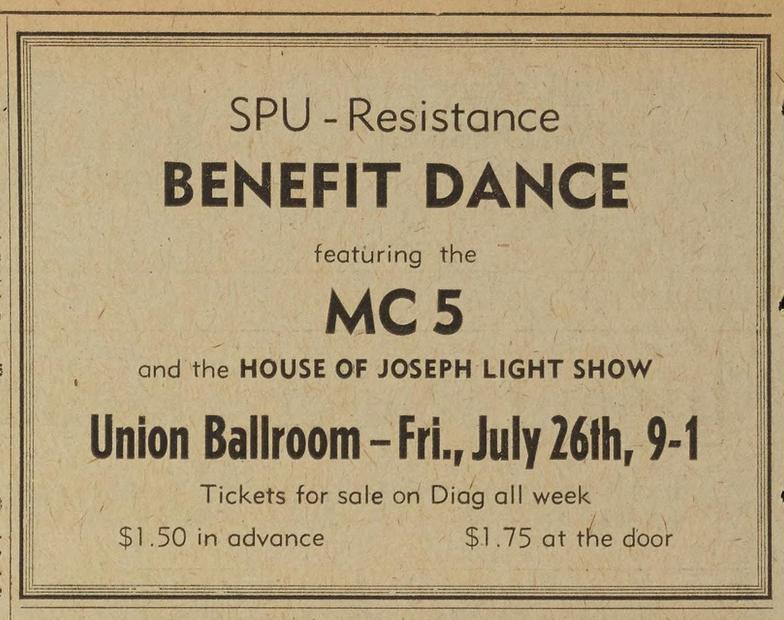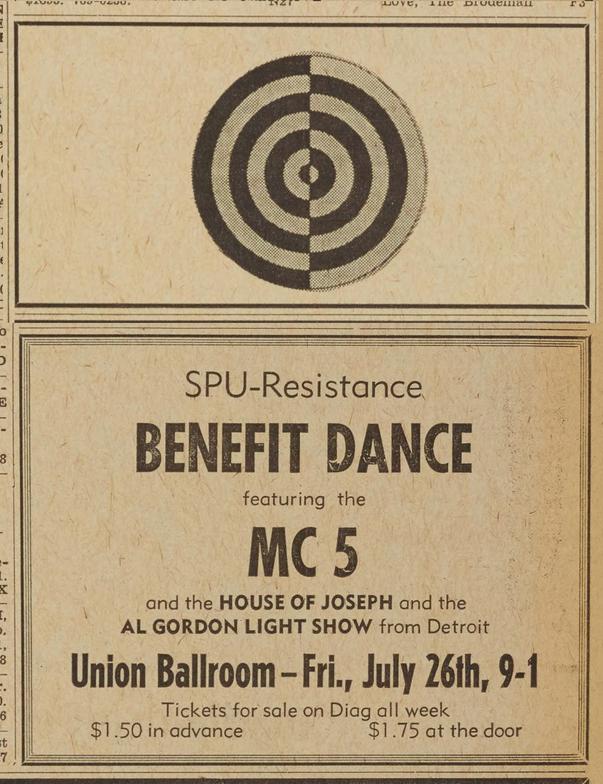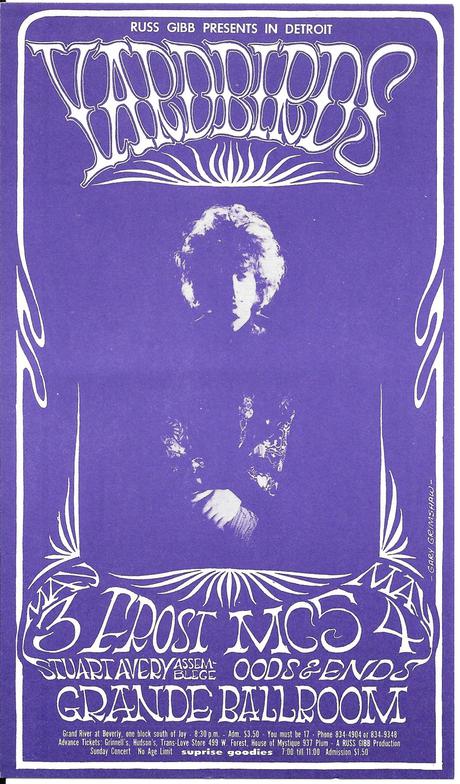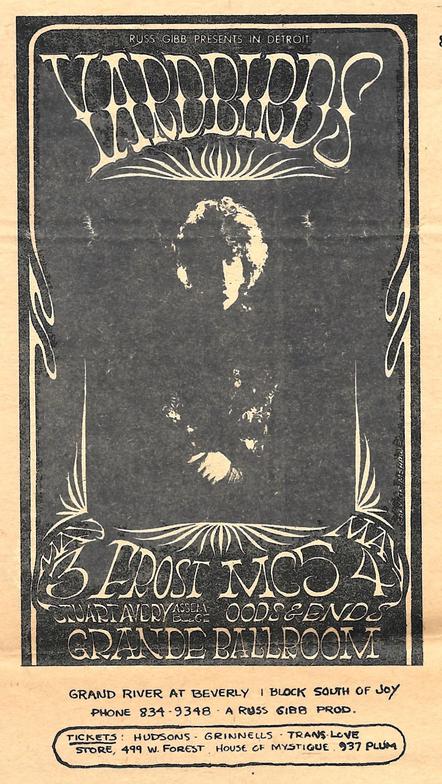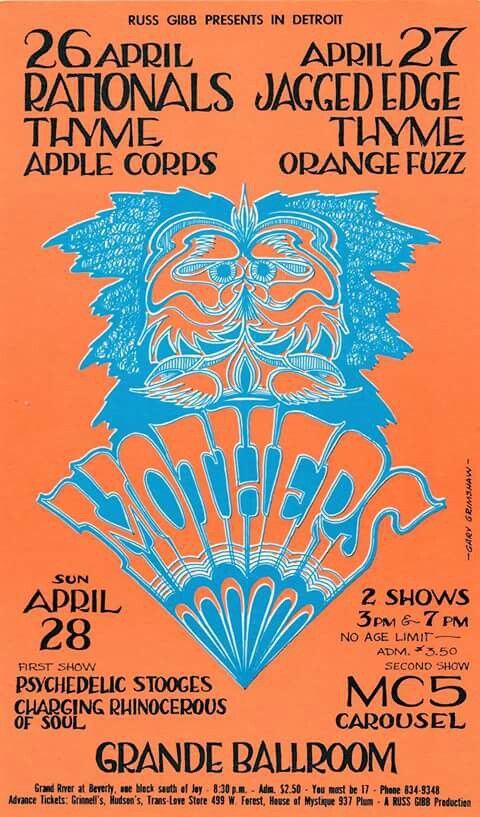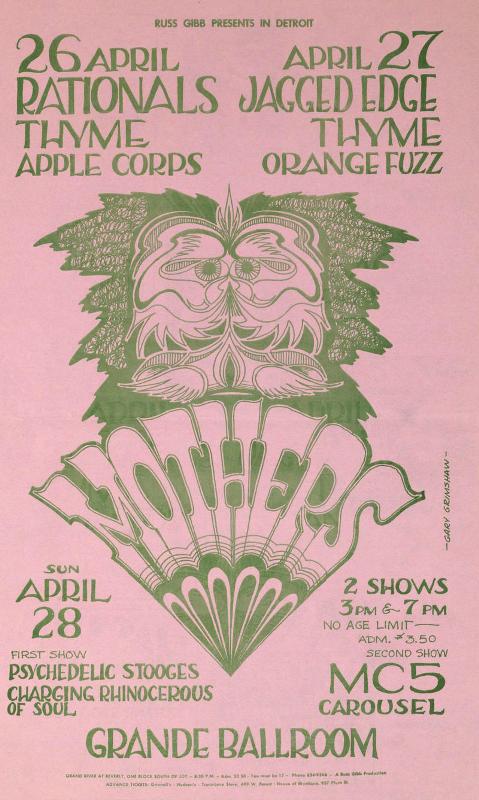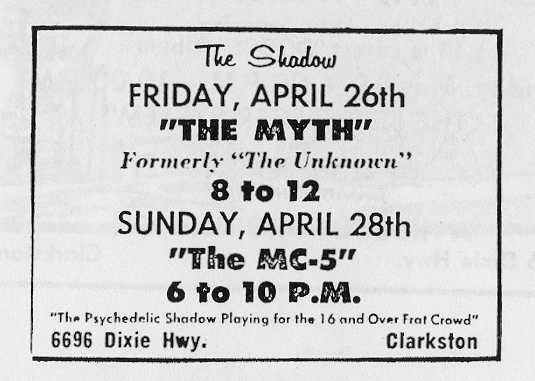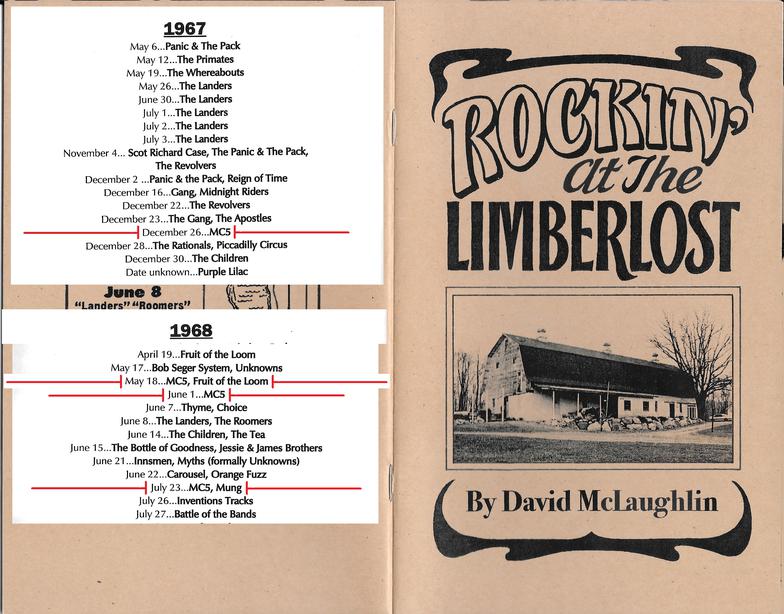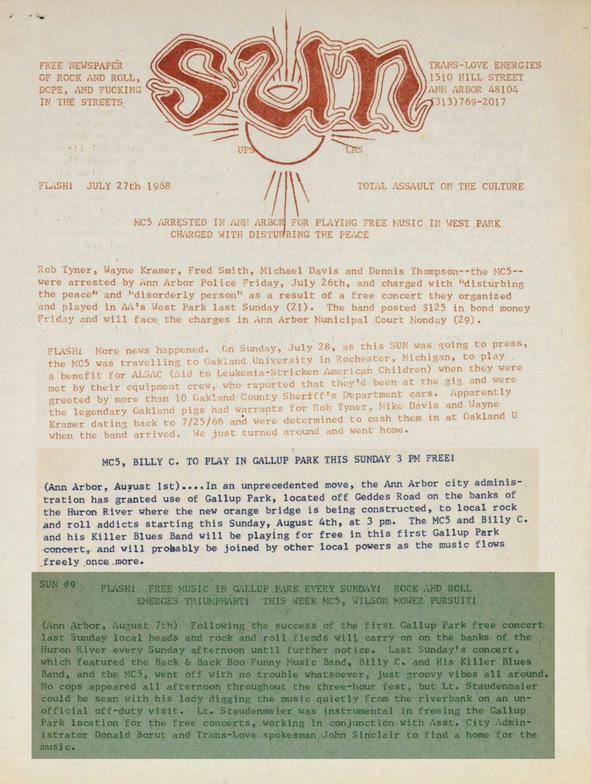Splatt Gallery
Double click here to add text.
Splatt Gallery's History of Michigan Music Posters
MC5 - Page Four
***********************************************************
Punch Andrews opened yet another club, at the Raven Gallery’s Birmingham, Michigan outpost, and called it The Village Pub. This poster by unknown artist Ron Schugglee is for an April 27, 1968 show with The Seven Sounds and The Bottle Company. It also advertises an upcoming May 4 show with The MC5.
There are only about a half-dozen documented shows at the Village Pub for the year 1968, but when we get to 1969, the venue will have established a fairly reliable weekly schedule and a steady run of posters, including James Render and others.
Handbill by an unknown artist for a May 4, 1968 appearance by MC5 and the UP at the Village Pub in Birmingham, Michigan, and for Panik & the Pack and the only known appearance by House of Josef, the following week on May 11th.
This conflicts with the MC5 opening for the Yardbirds at the Grande Ballroom on May 4th, but it is not impossible that the band could have made both gigs. Both shows are listed in the Database and the Gateway.
The 84th weekend at The Grande Ballroom, May 10-12, 1968 featured Gary Grimshaw’s 49th poster for the venue. The James Cotton Blues Band headlined two nights, with MC5 opening both nights, May 10-11, 1968, with the Buffy Reed Phenomena and the UP one night each. The poster also includes a Sunday show, on Mother’s Day, May 12th, with appropriately named groups Children and Eastside Orphans.
When John and Leni Sinclair returned home after a night at the Grande, they discovered their house, which also served as the offices for Trans-Love Energies, had been fire-bombed. No one was hurt since they’d all been at the show, but this was the second time this had happened, and the Detroit police, seemingly uninterested in investigating these crimes, were instead increasingly becoming a source of intimidation and harassment.
So Sinclair decided to move the entire operation, with the commune of 28 people, including the MC5 and The Up, family and friends, away from the city of Detroit and out to Ann Arbor, where he found two large, adjacent houses on Hill Street.
Five years after joining up with the group at the Red Door Gallery and starting the Detroit Artists Workshop, Sinclair was leaving the city that had informed him and emboldened him, that had inspired his writing, opened his mind to rock and roll, and kept him well supplied with weed and acid.
There was also a “Programme” printed up for the May 10-11, 1968 weekend at the Grande Ballroom with this cover art by Gary Grimshaw. The inside pages and back cover, which detail the MC5's two set lists, are shown below, large enough that they should be readible.
Ad for The Loft in in Leonard, Michigan with Bob Seger on May 17 and the MC5 with Fruit of the Loom on May 18, 1968. A second ad lists another teen club appearance, at the Hullabaloo in Benton Harbor, Michigan with an opening band called Chances R on May 21, 1968. The description of their act certainly puts them beyond the typical teen club band.
On the weekend of May 24-25, 1968, the MC5 appeared at the Detroit Castle with a very distinctive poster made by R.V. Rubyan, who turns out to be artist Robert Rubyan as confirmed by his long resume, which includes living down the street from the Algiers Motel at the time of “The Incident”, being mentored by John Sinclair while at Wayne State University, working at the Detroit Institute of Arts before moving to New York, being on the ground floor of the launch of Photoshop in 1988, to dodging falling debris from the World Trade Center on 9/11.
http://www.rubyanart.com/
The 86th weekend at the Grande Ballroom, May 24-26, 1968 featured Gary Grimshaw’s 51st poster for the venue. The Butterfield Blues Band headlined three shows, with support by Frost and Buffy Reed Phenomena, Jagged Edge and Fox, and on Sunday night, May 26, 1968, with the MC5 and Psychedelic Stooges.
Though now based in Ann Arbor, the MC5 continued to play the Detroit teen club circuit, including The Psychedelic Shadow (formerly a Hullabaloo) in Clarkston, The Loft in Leonard, and The Hullabaloo in Benton Harbor. On May 31, 1968, they came to The Hideout in Grosse Pointe, which was not one of the teen clubs started by Dave Leone and Punch Andrews, but more likely, someone capitalizing on the Hideout name.
Attendance at the Hideout clubs was beginning to wane, but for the MC5 it swelled to over-flowing for the first time in months. While the opening band, Third Power, played their set, John Sinclair and drummer Dennis Thompson were out in the parking lot, smoking pot with a group of fans and got busted by the security guards who called the Harper Woods police to the scene. The rest of the band was outside confronting the police when equipment manager, Ron Levine announced from the stage that the cops were arresting the band and urged the crowd to go outside. Levine was hustled off the stage by the police and the doors were locked to keep the kids inside.
The club manager persuaded the police to only arrest the ones that owned the weed and the MC5 were allowed to perform as planned. The incident only emboldened the band, as Wayne Kramer exclaimed, “It was the people versus the pigs, and the people won!”
Gary Grimshaw’s poster for the show featured Leni Sinclair’s photograph of the band shirtless in front of a backwards American flag, that would become a standard image for the band. “Break through the American Stasis with The MC5.”
The story of this show is told in detail in John Sinclair's "Rock & Roll Dope" column he was writing for the Fifth Estate newspaper:
http://makemyday.free.fr/guitarmy1.htm#d
The 88th weekend at The Grande Ballroom, June 7-9, 1968 featured Gary Grimshaw’s 54th poster for the venue. It was the return of Cream with the make-up shows for earlier cancellations in April. Grimshaw re-used the band image from the earlier poster with the addition of a new paisley border.
Cream headlined all three nights, with support by Carousel and MC5 on June 7, 1968, Nickel Plate Express and St. Louis Union on June 8th, and the James Gang, and Thyme on June 9th.
Also shown is a very strange ad.
It was the fourth time at the Grande Ballroom for the Cleveland band, The James Gang, finding themselves very popular in Detroit. “The Gang” were appropriately named as no less than 23 members had passed through its ranks by this time. Guitarist Joe Walsh had joined the band at the beginning of 1968 making it a five-piece ensemble at the time, but with the departure of their keyboard player they were down to four members by the time of this show.
At the last minute, as they were about to go onstage at the Grande Ballroom, their second guitar player informed them he would not make the show. Needing the money, Walsh had the band go on stage as a power trio and they were so pleased with the results, they decided to remain that way.
The MC5 continued booking clubs wherever and whenever they could. On June 12, 1968, they performed a Wednesday night show at the Lansing Hullabaloo teen club (no poster yet found). The above poster by artist Greg DeHike was made for a show at the Village Pub in Birmingham, Michigan on June 15, 1968 with opening band, The Zue.
Other teen club appearances that we have not confirmed with either an ad or a poster were June 12 at the Hullabaloo in Lansing, June 13 in Sarnia, Ontario, June 16 at the Michigan State Fairgrounds, June 21 at the Hullabaloo in Benton Harbor (ad shown above), also, June 21 in Walled Lake, June 22 in Benton Harbor, June 26 in Tecumseh, June 28 at the Hullabaloo in Jackson, June 29 at at Romulus Greenlawn Grove, July 5 at the Pumpkin in Wayne, July 6 at Lakeland Castle in Caseville, July 8, and/or July 10, at the Hideout in Grosse Pointe, and July 10 at the Hullabaloo in Ann Arbor.
The 90th weekend at The Grande Ballroom, June 21-23, 1968 featured Gary Grimshaw’s 55th poster for the venue and his fourth in his new motif of flowing shapes over a background circle. Blue Cheer headlined three shows, with support by Jagged Edge, Soul Remains (two nights), Nature’s Children, and on the third night, Sunday, June 23, 1968, by MC5 and Psychedelic Stooges. These shows were Blue Cheer’s Michigan debut.
Blue Cheer made music that sounded like it could have come from the Motor City, much more akin to the MC5 and the Stooges than to the Grateful Dead or Jefferson Airplane. In fact, Dickie Peterson was another Midwest transplant, moving to San Francisco from the North Dakota border with Minnesota. As much as anybody, Blue Cheer invented heavy metal and were the originals in LOUD music.
Yes, they were so loud that their second album was recorded on a pier in New York Harbor since the studio couldn’t contain them, yes, they were named after a batch of LSD, yes, they were managed by an ex-Hells’s Angel named Gut, and yes, their first album had the super cool name, Vincebus Eruptum.
Drummer Paul Whaley, whose performance in this clip must certainly have been an inspiration for Dale Crover of (The) Melvins, when pressed by the plastic Dick Clark to define Blue Cheer’s sound, simply says “Heavy”.
Also to their credit, they were hated by rival bands and despised by a newly emerging breed of assholes called “rock critics”. The plastic Dick Clark, after his stilted interview and half-praise on air, told the band after busting them backstage smoking hashish, “You’re the kind of band that gives rock and roll a bad name”. The band replied, “Thanks Dick”.
Blue Cheer – Summertime Blues (1968)
https://www.youtube.com/watch?v=KKT0Kz5VGhw
Emboldened by having avoided arrests and getting the cops and the club owner to back down, by inciting the crowd at The Hideout, The MC5 continued to push the limits at their original home, the Grande Ballroom. On the night of the Cream show, Russ Gibb caught wind of the band’s plan to burn an American flag on stage. He told them, in no uncertain terms, that if they did that he would call the police, so alternatively the band ripped the flag to shreds without incineration and hoisted a marijuana leaf banner while Jerry Younkins paraded around the stage completely nude. This was still enough to enrage the ballroom owner Gabe Glantz who fired the ballroom manager Larry Feldmann and the situation created a frosty gulf between Gibb and the MC5.
Their next appearance at the Grand Ballroom was the Blue Cheer show. Glantz showed up and warned the band against any similar shenanigans and when the band refused to commit to any such promises, he forbid the band from going on stage. After an hour of back and forth arguments while the crowd got increasingly restless, the manager for Blue Cheer said that if the MC5 were not permitted to play then Blue Cheer would also not go on, causing Glantz to relent but their set was cut short leading to more acrimony between the band and Russ Gibb.
John Sinclair pointed out the band was only making $125 a night at The Grande, the six-person light show was making $25 and Gary Grimshaw was paid $25 per poster design.
The repercussions from reports of onstage nudity, flag mutilations, and obscene lyrics caused the city council in Jackson, Michigan to force the owners of The Hullabaloo club in that city to cancel the June 25, 1968 scheduled appearance of The MC5. Two days later, on June 27, 1968, the band did appear at the Sturgis Armory in Sturgis, Michigan, from which there is this recording of the full show.
Their stage show had developed a standard opening where Wayne Kramer would lead the band through a rendition of “Rambling Rose” after which Rob Tyner would come onstage with the shout of “Kick out the jams, motherfuckers!” The routine became so well known that the police would show up just to wait for the utterance of the magic obscenity. At a show at the Grosse Pointe Hideout, Tyner told the audience, “You know the five words” and the crowd shouted it out, frustrating the cops who knew they couldn’t arrest everybody in the place. In this Sturgis show, you’ll hear Tyner skirt around the taboo phrase, shouting “Kick out the jams, mother-fu-fu-fu-fu”.
Poster made by unknown person.
The whole set was recorded with a reel-to-reel tape deck plugged into the MC5s soundboard. The recordings are available on various discs.
The MC5 – Live at the Sturgis Armory (1968)
https://www.youtube.com/watch?v=pLMvNHZz-Go
Work/5 published by the Detroit Artists Workshop, July 1968. The front cover was a photo by Leni Sinclair of the MC5 live on stage at the Grande Ballroom.
Seven years after a town riot had put an end to the annual Jazz Festival in Saugatuck, Michigan, somehow, novice promoter Mike Quatro negotiated the use of the nearby Potawatomi campgrounds to stage the 1968 Fourth of July Saugatuck Pop Festival.
On July 4, 1968, the MC5 performed without incident and John Sinclair credited the “cool promoter” with creating the hassle-free (ie, no cops) environment and allowing “the band’s natural chemistry.to work its magic.” Wayne Kramer debuted a Stratocaster painted in the red, white & blue stripes by artist Robin Sommers, the guitar did not survive the end of the show. The only let-down was that The Amboy Dukes, who had been dying to get onstage all day, had to be cancelled due to a sudden rain storm.
Otherwise, Quatro had presented a satisfying, trouble-free day. In addition to the MC5 and the Dukes, the festival also included local favorites, The Rationals, Frut of the Loom, The Finer Things, Girls Inc, the Misty Wizards, The Up, and The Thyme, and an eclectic list of out-of-towners, The Flock from Chicago, The Tikis (later Harpers Bizarre) featuring Ted Templeman, and Nirvana from the UK.
The poster is signed by an artist named Melks although apparently, some copies have been seen that were signed by Gary Grimshaw.
Poster by Carl Lundgren for the Saugatuck Pop Festival, July 4, 1968.
A new club called Mother’s opened in Romeo, Michigan on July 5, 1968. John Sinclair had high praise for the owners, a group called United Peach, and claimed “We’ve never played in a better place” when the MC5 performed on July 7, 1968. The show review in Sinclair's "Rock & Roll Dope" column also included reviews of shows at the Grosse Point Hideout on July 8, and the Ann Arbor Hullabaloo on July 10.
The poster is by Luke Engel who was the owner of Mother’s and the person behind United Peach.
There is a hard-to-find book about The Loft, formerly Club Limberlost, in Leonard, Michigan written by David McLaughlin about the converted barn dancehall that had a three-year run starting in 1967.
The MC5 had performed there on June 1, 1968 without incident but were stiffed on payment after their check bounced. Nevertheless, they agreed to return for a performance on July 23, 1968 on the promise they would be repaid for the past show and given 40% of the new night’s gate receipts. When the band arrived they were informed that the owner only had $100 of their money up front but they went on and after only three songs, the club’s rent-a-cops told them they had to stop the show because obscene lyrics had been uttered.
The band persisted with one more song while denouncing to the crowd that the club owners were cheats and the rent-a-cops called the Oakland County Sheriff to report that the MC5 were inciting the crowd to riot. By the time the sheriffs arrived, the band had left the stage and John Sinclair was removing the equipment while the club owner was imploring him to bring the band back so that he wouldn’t have to refund the kids’ money and the rent-a-cop was still yelling at him to leave. Sinclair finally lost his cool and slugged the rent-a-cop in the face, prompting the other cops to pummel Sinclair. Fred Smith had returned and seeing Sinclair being beaten, jumped into the fray. Most of the audience was still inside as the rent-a-cops had barricaded the exits so that the sheriffs wouldn’t arrive to an empty barn instead of the riot scene they had described and the kids watched in horror as the bloody beatings took place on the stage. Sinclair and Smith were taken to the county jail in Pontiac, booked on charges of assault and battery of a police officer and released on bonds of $2,500 each.
TheMC5 – Baby Please Don’t Go (1966)
https://www.youtube.com/watch?v=yvqTHqNcOnA
A pair of flyers by an unknown artist, in support of MC5 guitarist Fred Smith and MC5 manager John Sinclair, related to their arrest following the July 23, 1968 show at the Loft in Leonard, Michigan.
The MC5 were not getting off to a great start in their newly adopted home of Ann Arbor, Michigan. On July 10, 1968, they had their first show in town at the newly opened Hullabaloo just a few blocks away from their Hill Street headquarters. By the time the MC5 started their set, seven squad cars of Ann Arbor police arrived and pulled the plug on the show for being “too loud”. The band and their entourage grabbed horns, gongs and drums and carried on with an acoustic racket. A cop came onstage and gave John Sinclair a ticket for “noisy band” that Sinclair ceremoniously ripped up and the band went home feeling somewhat smug over what they saw as another victory.
Four days later on the following Sunday, July 14, they decided to take it upon themselves to revive the summer free concerts in West Park. As we’ve recounted earlier, at the end of the 1967 summer season the Ann Arbor city council had passed a resolution banning “high output electronic musical instruments” in public parks. After playing for about an hour, the police and the town mayor showed up and shut them down, although the mayor told Sinclair he would re-examine the ban.
With no word from the mayor a week later, the MC5 went back to West Park again on Sunday, July 21, 1968, and started playing for a small crowd, and again the police showed up and shut it down, this time telling the band that formal complaints had been filed by neighbors near the park and that the band would receive citations.
On Friday, July 26, 1968, three days after the altercation and arrests of John Sinclair and Fred Smith at The Loft, the MC5 regrouped for a benefit show at the Michigan Union Ballroom in Ann Arbor. When they arrived for the show, all five band members were arrested on charges of disturbing the peace and disorderly conduct on warrants from the West Park concert the week before, taken to jail, charged and released on bond.
The following Sunday, July 28, with no prospect of playing West Park again, the MC5 were booked to play at an ALSAC benefit at Oakland University in Rochester, Michigan, but as they got near the venue their equipment crew who had gone in advance, intercepted them and warned them that the Oakland County Sheriff’s Department were waiting for them with warrants for several of the band members on various charges dating all the way back to the summer of 1966. They turned around and went home.
So if you’re keeping count, in the month of July, 1968, the MC5 had six shows shut down by the police, seven arrests, and two shows cancelled.
The poster for the July 26, 1968 Benefit at the Michigan Union was designed by Gary Grimshaw, himself in exile avoiding arrest.
The MC5 returned to the Village Pub in Birmingham, Michigan on July 27, 1968, and as with their show the month before, someone named Greg DeHike made a rudimentary line-drawn poster on blue paper. Nothing else is known about Mr. DeHike, although Michael Erlewine includes his name on his list of Midwestern poster artists
The front cover of the August 1, 1968 issue of the Fifth Estate newspaper in Detroit, Michigan, with the headline on the July 23rd altercation with the MC5 at the Loft.
A full page of MC5 news, including the July 23rd altercation at the Loft, from the August 1, 1968 issue of the Fifth Estate newspaper in Detroit, Michigan. Photo by Leni Sinclair.
Continued coverage of the MC5 in the August 1, 1968 issue of the Fifth Estate newspaper in Detroit, and another photo by Leni Sinclair.
An ad for the debut single by the MC5, on A-Squared Records, in the August 1, 1968 issue of the Fifth Estate newspaper, with disc label artwork by Gary Grimshaw.
On Sunday, August 4, 1968 the Free Concerts in Ann Arbor were back. John Sinclair had worked out a deal with the Ann Arbor city council with the result being that the concerts were moved from the residential West Park to Gallup Park down on the Huron River. The new location was actually ideally better suited, and old friends, The Back & Back Boo Funny Music Band were back, along with Billy C. & His Killer Blues Band (the intermediate step between his Sunshine band and Commander Cody), and the MC5 could finally kick out the jams. Photo by Leni Sinclair.
John Sinclair finally found a location for the Sunday Free Concerts that was agreeable to the city of Ann Arbor, moving from West Park, where the year before neighbors had complained and bands had been arrested to the more isolated Gallup Park on the bank of the Huron River. The first one, on August 4, 1968, had gone off so unnoticed that the city called on Monday to see if the concert had actually happened, and then granted Sinclair permission to use the park all he wanted. The concerts continued, every Sunday, throughout August and September, 1968, all of them headlined by The MC5.
The MC5 returned to Mother’s in Romeo, Michigan on August 8, 1968, John Sinclair’s professed favorite venue, where it appears that the poster for the show was made, once again, by club owner Luke Engel.
Carl Lundgren poster for Mike Quatro presentation of the MC5 at Knights of Columbus Hall in Mt. Clemons, Michigan on August 20, 1968, rechristened, as we’ve seen with other venues as “The Boogie”. Photograph of The MC5 by Leni Sinclair.
In the build-up to the pending disaster of the Democratic national convention in Chicago in 1968, Abbie Hoffman announced plans for a “Festival of Life” concert featuring the Jefferson Airplane, Country Joe & the Fish, The Fugs, and The MC5, among others, but all of the scheduled performers ended up canceling and staying away, except for The MC5, who arrived at Chicago’s Lincoln Park on August 25, 1968, set up on the grass, ran an extension cord to a nearby hotdog stand for power, kicked out the jams, jumped in their van and escaped just before the shit hit the fan.
Here is a Department of Defense surveillance video that captures parts of the MC5’s performance. It’s a silent video, so just consider author Norman Mailer’s description, “had the horns of the Huns ever had noise to compare?”
https://www.youtube.com/watch?v=C5sA6a0g31U
The MC5’s mad dash into, and out of, the riots during the Democrat national convention in Chicago, August 25, 1968, was the first time they had performed in another state outside of Michigan (not counting two prior shows in Canada), they gained admiration in the national underground for being the only ones crazy enough to pull it off, and a Gilbert Shelton tribute.
It’s kind of surprising that The MC5 would go back to The Loft in Leonard, Michigan just a month after they were ripped off by the owner and beaten and jailed by the police there, but apparently, the “new management” as noted on the poster for this show by an unknown artist on August 27, 1968, must have made a difference (was it Bother Don?). As far as we know, the show was uneventful and the kids kicked out the jams.
The MC5’s next gig was at the Oddfellows Hall in Dearborn, Michigan on August 29, 1968. Apparently, this show was taped and broadcast on WABX radio. There’s a nine-song track list for the tape, with a couple of interludes that suggest how it went, after the fourth song there’s one called “I ripped my pants dialogue” and at the end of the set there’s one called “They’re gonna call the police dialogue”. Poster by an unknown artist.
A second poster for the Oddfellows Hall show on August 29, 1968 by a second unknown artist.
On September 1, 1968, Russ Gibb presented the Oakland Pop Festival at Oakland University in Rochester, Michigan. Some history books report that The MC5 turned around on their way to the event and cancelled their appearance for fear of Oakland County sheriffs waiting with warrants for their arrests, but they must be mistakenly thinking of the incident the month before for the ALSAC benefit at the same location since the newspaper review of the Oakland Pop Festival in The Detroit Free Press describes their appearance.
The Free Press review does report that an announcement was made that the band was having trouble with the local police and might not appear, which angered the crowd, but they did appear to standing ovations for their introductory and final numbers. The review concluded that the only major complaint came from “some male groupies” who complained that the band was paid only $64 for doing the show.
Carl Lundgren made the poster, and both the poster and the newspaper ad promised the appearance of Pink Floyd, probably anticipating that they would wrap up their summer 1968 tour of the US with a return visit to Detroit, but Pink Floyd made a live recording in Amsterdam that night. Also advertised, but not appearing, were Howlin’ Wolf and Chrysalis, which had been the Grande Ballroom acts that weekend.
MC5 – Look at What You Done Done (1968)
https://www.youtube.com/watch?v=kZVdisfh8Kk
For the weekend of September 6-8, 1968, John Sinclair brought his Trans-Love tribe back to their old stomping grounds of Cass and Forest streets in Detroit for the Dialogue ’68 Festival at the First Unitarian Church. It had been JC Crawford, the drummer who replaced Iggy in the Prime Movers, who had introduced Sinclair to the idea of forming The Church of Zenta in order to avoid paying taxes on the Ann Arbor properties, and also, incidentally, to protect them from prosecution on drug charges by claiming that dope was a holy sacrament of the church.
Crawford, in full Zenta preaching mode, delivered a fire-and-brimstone revival-type sermon to introduce the band at the Sunday night show, and they loved it so much that they hired Crawford to open all of their future shows in similar fashion. The MC5 performed on two of the nights, September 7-8, 1968.
Also noteworthy was the appearance of a band from Saginaw, Michigan called Popcorn Blizzard, featuring a large lead singer named Marvin Lee Aday, better known as Meatloaf.
The poster was made by Robin Sommers.
Poster History of the MC5 - continues - HERE
An ad for the MC5 at the Hullabaloo in Benton Harbor, Michigan on August 9, 1968. The band is described as "the hit of the Saugatuck Band Festival".
John Sinclair began writing his “Rock & Roll Dope” column for the Fifth Estate newspaper in Detroit, with the June 4, 1968, issue. It became a diary of the MC5's summer of ’68.
John Sinclair’s second “Rock & Roll Dope” column in the Fifth Estate newspaper described the May 31 show at the Grosse Pointe Hideout in detail, as well as opening for Cream at the Grande Ballroom on June 7, and a show at the Lansing Hullabaloo on June 12, 1968.
It also provided the itinerary for the rest of the month as, Sarnia, Ontario (June 13), the Birmingham-Bloomfield Teen Center (June 15), Michigan State Fairgrounds (June 16), “Russ Gibb’s new dancehall at Walled Lake Amusement Park” (June 21), a Benton Harbor Scene (June 22), at the Grande with Blue Cheer and the Psychedelic Stooges (June 22), a return to the Grosse Pointe Hideout (June 26), the Jackson Hullabaloo (June 29), and Romulus Greenlawn Grove (June 29). Also, headlining the First Saugatuck Pop Festival (with the Amboy Dukes and the Rationals) on the 4th of July.
In John Sinclair’s report on the Saugatuck Pop Festival, he described the debut of Wayne Kramer’s Stratocaster guitar that had been decorated by Robin Sommers for the 4th of July festivities. In addition to the red and white striped body and blue pick-guard with white stars, it also had an American flag hanging from the tuning pegs.
“Truly an all-American guitar, and fit to be freed. The energy built up and up and up until people couldn't stand it any longer, and finally Kramer stepped back, unstrapped his star-spangled Fender, and began mashing it against the low ceiling beams of the stage until it cracked, and then finished if off against the floor and against the bank of Sunns behind him.”
The column also described the shows at The Pumpkin in Wayne, Michigan on July 5, 1968, and at Lakeland Castle in Caseville, Michigan on July 6, 1968:
"Friday night took the band to the Pumpkin out in Wayne, Michigan, for "psychedelic night", and a groovy time was had by all, with no funny shit going down, just good music and good vibes. Saturday night it was Caseville, Michigan, at the Lakeland Castle, for 1500 eager fans, and although the place was surrounded by cops of every description - state pigs, county sheriff pigs, township pigs, and hired guards - everything went off smoothly."
Initially, Russ Gibb was considering managing The Psychedelic Stooges, he was friends with Iggy’s dad through school connections and was a confidant and supporter, but in the end they became part of the Trans Love Energies family. John Sinclair managed The MC5, his brother David managed The Up, and The Stooges brought along their friend Jimmy Silver, officially elevated to band manager.
John Sinclair’s “Rock & Roll Dope” column in the July 4, 1968 issue of the Fifth Estate newspaper in Detroit had the MC5’s itinerary for the first half of July, with the Pumpkin, in Wayne, Michigan, July 5, 1968; the Lakeland Castle in Caseville, Michigan, July 6, 1968; Grosse Pointe Hideout, July 8, 1968; Ann Arbor Hullabaloo, July 10, 1968; Toledo Hullabaloo, July 13, 1968; Bay City (Michigan) Roller Rink, July 16, 1968; and Sherwood Forest (Davison, Michigan), July 17, 1968.
Page One of the Programme
Page Two of the Programme
Page Three of the Programme
The 83rd weekend at The Grande Ballroom, May 3-4, 1968 featured Gary Grimshaw’s 48th poster for the venue. The Yardbirds headlined both nights, with support by Stuart Avery Assemblage and Frost on the first night, and with MC5 and Odds & Ends on the second night, May 4, 1968.
This was the final Yardbirds tour before Jimmy Page left to start Led Zeppelin.
A newsprint version of Gary Grimshaw’s poster for the Yardbirds at the Grande Ballroom, May 3-4, 1968.
The 82nd weekend at The Grande Ballroom, April 26-28, 1968 featured Gary Grimshaw’s 47th poster for the venue. The poster has four shows. The Rationals, Thyme, and Apple Corps performed on April 26th, Jagged Edge, Thyme and Orange Fuzz performed on April 27th. The two Sunday shows by Frank Zappa & the Mothers of Invention on April 28, 1968, were their only Grande Ballroom appearances. The Psychedelic Stooges and the Charging Rhinoceros of Soul opened the first show, and the MC5 and Carousel opened the second show.
Also shown is the version of Gary Grimshaw’s Mothers poster as it appeared as the back page of Issue #7 of the SUN newspaper, April 19 – May 2, 1968.
There are a number of tracks in circulation taken from a soundboard recording of The Mothers at The Grande Ballroom on April 28, 1968. Here’s the “Let’s Make the Water Turn Black/Harry, You’re A Beast/Orange County Lumber Truck” medley.
Mothers of Invention – Medley Live Grande Ballroom (1968)
https://www.youtube.com/watch?v=FBBx5NteFDI
An ad for the MC5 at the Shadow, the re-named Clarkston Hullabaloo in Clarkston, Michigan on April 28, 1968. This seems to be in direct conflict with opening for the Mothers of Invention late show at the Grande Ballroom with a start time of 7 PM.
A show list for The Loft from David McLaughlin’s “Rockin’ at the Limberlost” that has four MC5 shows, including the two previously posted (December 26, 1967 and May 18, 1968), plus June 1, 1968 when the band was stiffed on their payment leading up to the altercation on July 23. 1968.
The SUN newsletter in Ann Arbor was being issued “whenever feasible” but it was keeping up with the exploits of the MC5. A July 27, 1968 issue confirmed the Sunday Free Concert at West Park on July 21, 1968. An undated issue confirmed the Sunday Free Concert at Gallup Park on August 4, 1968, describing the negotiations with the Ann Arbor city council to secure the new site. And SUN #9, dated August 7, 1968 provided a review of the August 4th concert and announced the MC5 with Wilson Mower Pursuit for the next one upcoming on August 11, 1968.


